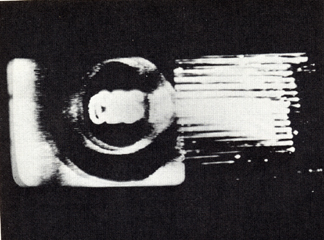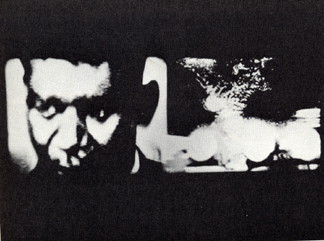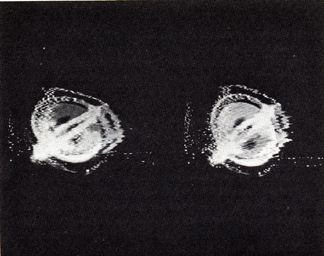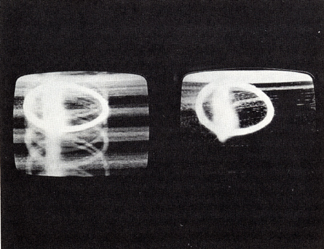| Publication Type | Book |
| Authors | Youngblood, Gene |
| Source | (1970) |
| Keywords | people-text |
"The real issue implied in art and technology," he has said, "is not to make another scientific toy, but how to humanize the technology and the electronic medium. ... I suggest Silent TV Station, which transmits only beautiful 'mood art' in the sense of mood music. What I'm aiming at with my Lissajous figures and other distortions is a television equivalent of Vivaldi, or electronic Compoz. Lumia art will then become a permanent asset in the collections of millions of people. The Silent TV Station will simply be there, not intruding on other activities, and will be looked at exactly like a landscape or a beautiful bathing nude of Renoir. Normal TV bores you and makes you nervous; this soothes you. It's like a tranquilizer. Maybe you could call it video-soma.">
Paik's exquisite sense of satirical irony comes through most effectively in his video sculpture pieces. In TV Bra for Living Sculpture, Paik covered cellist Charlotte Moorman's bare breasts with two tiny three-inch TV sets whose images were modulated by the notes played on her cello. "Another attempt to humanize technology," Paik explained. For an exhibit titled "The Machine at the End of the Machine Age" at the
Aldo Tambellini: Black TV>
"Our creative involvement with television must begin now so that the electronic energy of communication can give birth to new visions: we will face the realities which astronauts and scientists know to be part of life.">
Intermedia artist and filmmaker Aldo Tambellini has worked creatively with television in many ways for several years. He has produced synaesthetic videotapes, videographic films, and closed-circuit teledynamic environments. All of his work, in whatever medium, is concerned with the theme of "black," both as idea and experience. For Tambellini, black is the womb and the cosmos, the color of skin and the color of the new consciousness. "Black is the beginning," he says. "It is birth, the oneness of all, the expansion of consciousness in all directions."
Tambellini began working with videotape in 1966-67 as part of his intermedia presentations. This work was subsequently expanded into live, closed-circuit, and broadcast video experiments. In the spring of 1969, Tambellini became the recipient of a grant from the New York State Council on the Arts in a project to develop relationships between artists and television engineers. He worked with technologists at five educational TV stations throughout
Also in 1969 he was one of six artists participating in the PBL program "The Medium Is the Medium" at WGBH-TV in
Black TV is the tide of Tambellini's best-known videographic film, which is part of a large intermedia project about American television. Compiled from filmed television news programs and personal experimental videotapes, Black TV has been seen in many versions during the four-year period in which Tambellini constantly re-edited it. "Since my interest, is in multimedia and mixed-media live events, and in experimental television, I think of film as a material to work with, part of the communications media rather than an end in itself. In the future we will be communicating through electronically transmitted images; Black TV is about the future, the contemporary American, the media, the injustice, the witnessing of events, and the expansion of the senses. The act of communication and the experience is the essential.
As Tambellini's remarks indicate, Black TV is about perception in the intermedia network. It generates a pervasive atmosphere of the process-level perception by which most of us experience the contemporary environment. Since it involves the use of multiple monitors and various levels of video distortion, there is a sense of the massive simultaneity inherent in the nature of electronic media communication. Black TV is one of the first aesthetic statements on the subject of the intermedia network as nature, possibly the only such statement in film form.
Black Video One and Two are representative of the techniques and approaches involved in Tambellini's videotape compositions. He calls them "video constructions" to emphasize that they are self-contained image- and sound-generating units, which do not take image material either from broadcast programs or closed-circuit cameras. Instead, special circuitry is devised to generate both image and sound electronically on two monitors. These completely synthetic videographics can be juxtaposed with other image material to create a sense of convergence between different worlds. As in most of Tambellini's work, archetypal white globes, spheres, or expanding coils are seen suspended in a black video void. Various forms of video noise are generated to accentuate the purely kinetic aspect of the tapes. Most of this work was first produced in 1967-68, and has been incorporated into Tambellini's intermedia presentations and films.
Black Video Two was exhibited at the Howard Wise Gallery in
"The artist will have to get to this medium and begin to explore all possibilities," Tambellini urges. "After all, television is actually an image made of light which travels through time and space. I'm interested in getting to that particular point to actually show that light is a constantly moving and ever-changing form, that light is energy, and the same energy which moves through us is the energy which moves through the universe. It is the same energy we have discovered in the atom. When creative people begin to get involved with this idea of energy rather than making objects for someone, they will be exploring possibilities for everybody, art will be an exploration for all of mankind."
Aldo Tambellini: Black TV. 1964-68. 16mm. Black and white. 9 ½ min. Two years of TV news compressed into a staccato barrage of sight and sound.


Aldo Tambellini: Black Video Two. 1968. VTR. Black and white. Both image and sound were generated electronically. Made in collaboration with engineer Ken Wise. Photos: Peter Moore.

